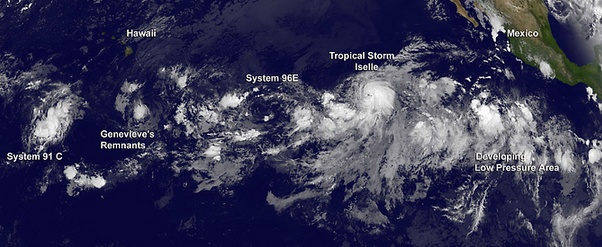Five tropical systems developing in the Central and Eastern Pacific

A train of developing tropical low pressure areas currently stretches from the Eastern Pacific Ocean into the Central Pacific. Five tropical lows include the remnants of "zombie" Tropical Storm "Genevieve" and newly developed Tropical Storm "Iselle".
NOAA's GOES-West satellite captured an image of the Pacific ocean on August 1 at 12:00 UTC that showed post-tropical cyclone Genevieve's remnants between three other systems. The GOES-West image shows the train of storms with a well-developed "Iselle" near the end of the train.

This NOAA GOES-West satellite image from August 1 shows a train of 5 developing tropical systems in the Eastern and Central Pacific (l to r): System 91C, Genevieve, System 96E, Iselle, and a tropical wave. Image credit: NASA/NOAA GOES Project.
System 91C
The western-most tropical low pressure area lies to the west of Genevieve's remnants. That low is designated as System 91C. At 06:00 UTC, the center of System 91C was located near 12.0 north latitude and 167.3 west longitude, about 1 370 km (850 miles) southwest of Honolulu, Hawaii. 91C has a low chance of developing into a tropical depression over the next couple of days.
East of System 91C lie Genevieve's remnants. NOAA's Central Pacific Hurricane Center (CPHC) issued the final warning on Post-tropical cyclone Genevieve on July 31 at 15:00 UTC. At that time it was centered near 13.0 north latitude and 151.1 west longitude, about 2 020 km (1 255 miles) east of Johnston Island. It was moving west.
Genevieve's remnants
At 12:00 UTC on August 1, Genevieve's remnant low center was located about 800 km (500 miles) south-southeast of Hilo, Hawaii. CPHC noted the atmospheric conditions are only marginally favorable for its redevelopment over the next few days as it moves westward near 16 km/h (10 mph).
System 96E
Continuing east, System 96E is tracking behind Genevieve's remnants. System 96E is another developing low pressure area with a minimal chance for becoming a tropical depression. The CPHC gives System 96E a 10 percent chance of development over the next two days. It is located in the Eastern Pacific Ocean, about 2050 km (1 275 miles) east-southeast of the Big Island of Hawaii. Satellite imagery shows the low is producing minimal shower activity. CPHC noted that upper-level winds are currently not conducive for development, but they could become a little more favorable in a few days while the low moves westward at around 16 km/h (10 mph).
Tropical Storm "Iselle"
Behind System 96E is the only developed tropical cyclone, Tropical Storm "Iselle". Iselle is located east-northeast of System 96E. Tropical storm Iselle was born on July 31 at 21:00 UTC. On August 1, Iselle's maximum sustained winds were already up to 95 km/h (60 mph). At 09:00 UTC the center of Tropical Storm "Iselle" was located near latitude 13.5 north and longitude 124.6 west. Iselle is centered about 1 870 km (1 160 miles) west-southwest of the southern tip of Baja California, Mexico.
Fifth Area of Low Pressure
The fifth tropical low pressure area is east-southeast of Iselle. That area is a tropical wave that is producing disorganized showers and thunderstorms. That wave is located several hundred miles south-southwest of Manzanillo, Mexico. The National Hurricane Center noted that environmental conditions are conducive for gradual development of this system during the next several days while it moves westward at 16 km/h (10 mph). NHC gives this low a 30 percent chance of becoming a tropical depression over the next two days.
Source: NASA Goddard
Featured image: NASA/NOAA GOES project

Commenting rules and guidelines
We value the thoughts and opinions of our readers and welcome healthy discussions on our website. In order to maintain a respectful and positive community, we ask that all commenters follow these rules:
We reserve the right to remove any comments that violate these rules. By commenting on our website, you agree to abide by these guidelines. Thank you for helping to create a positive and welcoming environment for all.